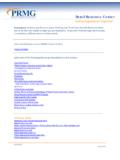Transcription of Ministry of the Interior, Kingdom of Saudi Arabia, …
1 Understanding the New Directives and their impact on the projects and existing security of industrial facilities in KSA Ministry of the interior , Kingdom of Saudi arabia , High Commission for Industrial Security HCIS HCIS: Who are they? HCIS: Who are they? HCIS History HCIS Approval Security Directives General Requirements (SEC-01) : The HCIS reserves the right to modify and/or make changes to the Security Directives without prior notice. : The criticality of each facility varies depending on the product or service provided. : The HCIS will have the ultimate authority on classifying all facilities. : The level of protection shall be dictated by its security classification. : All security design shall be carried out by qualified security consultants approved by HCIS.
2 : The operator shall develop a detailed security vulnerability assessment, or risk analysis, performed by a qualified security consultant, that shall be used as the basis of facility qualification. This SVA shall follow the API Methodology. The facility classification and Risk Analysis shall be submitted to HCIS for approval prior to security system design or implementation. The Security Directives SEC 01 - Application of Security Directives SEC 02 - Security Fencing SEC 03- Security Gate SEC 04 Security Lighting SEC 05 - Integrated Security Systems SEC 06 - Security Devices SEC 07 - Power Supply SEC 08 - Communications SEC 09 - Security Doors SEC 10 - Security Locks SEC 11 - Identification Cards SEC 12 - Identification Protection The HCIS Security Process.
3 Security Vulnerability Assessment (SVA) HCIS Approval Concept of Design (10%) HCIS Approval Front End Engineering Design (30%) HCIS Approval Detail Design (60%) HCIS Approval Detail Design (90%) HCIS Approval Issued for Construction (100%) FAT / SAT oSecurity Integrator Prequalification Review (HCIS bidder approval process required) oTechnical Scope of Work for client (Request for Proposal) oBid Evaluation (technical evaluation of integrator bids) oPolicy, Plan and Procedures oManpower Study oSecurity Awareness and Training Programmes Security Directives: Procedure Security Vulnerability Assessment (SVA) The plant owner commissions a Security Vulnerability Assessment to be carried out by an HCIS approved Security Consultant.
4 The SVA has to be carried out following the API methodology. The purpose of the SVA is twofold: critical assets, threats, risks, vulnerability and propose mitigation measures the facility according to a class 1 to 4 system. Security Directives: Procedure Concept of design (COD) After the approval of the Security Vulnerability Assessment, the plant owner commissions an HCIS approved Security consultant to take the results from the SVA and produce a security Concept of Design (COD) This Concept of Design (also called 10% Preliminary design) provides a design solution to the mitigation measures proposed and approved during the SVA exercise. Security Directives: Procedure Front End Engineering Design (FEED) After the approval of the concept of design (COD), the plant owner commissions an HCIS approved Security consultant to produce a Front End Engineering Document from the SVA and Concept of Design (COD).
5 The FEED (or 30% Design) will form the basis of the Technical Scope of Work that will form part of the Request for Proposal (RFP). This RFP will be issued to approved System Integrators to prepare a Tender Bid. The TSOW and RFP need not be approved by HCIS, but the FEED document does and the security system integrators must be approved by the HCIS. The EPC should submit the prequalification document of the security system integrator to the HCIS consultant for comment/approval before submission to the owner for transmission to and approval by the HCIS. Security Directives: Procedure Detailed Design 60% After the award of the security contract to an approved integrator the integrator will produce a 60% detailed design that is in accordance with the FEED design (30%).
6 The design will include details of all hardware and software to be used and will detail how the software is configured to produce an integrated system. The 60% detailed design is submitted to the HCIS approved consultant for comment and review before submittal by the EPC to the owner for transmission and approval by the HCIS. Security Directives: Procedure Detailed Design 90% After the approval of the 60% detailed design the Security Systems integrator will produce the 90% engineering submittal. This will include information on the total system down to individual field item level showing location, mechanical installation and all electrical terminations The 90% detailed design is submitted to the HCIS approved consultant for comment and review before submittal by the EPC to the owner for transmission and approval by the HCIS.
7 Security Directives: Procedure Issued For Construction After the approval of the 90% design package the Security Systems Integrator will prepare the system for the Factory Acceptance Test (FAT) The Security System Integrator will produce a FAT document for submittal and approval by the HCIS before the FAT is carried out . The FAT will be attended by the HCIS representative, the HCIS consultant, the owner and the EPC. The approved consultant will lead a Site Acceptance Test (SAT) and issue a Final Completion report (100%) for the HCIS. Requirements for Executing Fire Protection Projects (SAF) Designers, suppliers, contractors shall be approved by the HCIS. Contractors and suppliers shall be certified by the Ministry of interior (Civil Defense) and Ministry Commerce and Industry.
8 The Owner shall submit qualification documents to the HCIS for approval The Owner shall ensure that the company selected for safety and fire protection related work shal adequate engineering capabilities and qualified manpower to design, install, test and maintain the safet fire protection systems and execute all other work requirements competently.. The HCIS reserves the exclusive right to approve or reject any candidate design agency performin work. The Owner shall ensure that the company selected for safety and fire protection related work shal prior technical experience. The HCIS shall have the right to reject any equipment, system, or suppliers The Owner shall not permit any start on safety and fire protection related work until HCIS approv the design, contractor, major fire protection equipment and systems is received.
9 The Safety Directives (1) SAF 01 -Application of Safety and Fire Protection Directives SAF 02 - Environmental, Health and Safety (EHS) Management SAF 03 - Plant Buildings SAF 04 - Fire Protection Systems SAF 05 - Industrial Drainage SAF 06 -Plant Layout, Spacing, and Access SAF 07 - Well site Safety SAF 08 - Storage Tanks and Storage Vessels SAF 09 - Fireproofing in Plants SAF 10 - Pressure Piping, Pressure Vessels, and Transportation Pipelines SAF 11 - Emergency Shutdown, Isolation, and De-pressuring SAF 12 - Electrical Safety The Safety Directives (2) SAF 13 - Work Permits SAF 14 - Safe Manufacture, Transportation, Storage, and Use of Explosive Materials and Pyrotechnic Articles SAF 15 - Private Industrial Fleet Vehicle Filling Stations SAF 16 - Bulk Plants and Air Fuelling Support Facilities SAF 17 - Offshore Production Facilities SAF 18 - Mines and Mineral Processing Plants SAF 19 - Electric Power Generating Plants and Associated Facilities SAF 20 - Pre-Incident Planning and Management of Emergencies SAF 21 - Personal Protective Equipment SAF 22 Portable Electric and Electronic Devices Safety Directives.
10 Preliminary Design Phase HCIS Approval Detailed Design Phase HCIS Approval Operational Aspects (prior to operations) HCIS Approval Normally carried out at the FEED stage to produce a document that meets HCIS requirements and an EPC can bid against Produced by a local Saudi Fire contractor as part of a design, supply, install and commission contract Produced by either the owner or the EPC and must include all operational aspects of safety. Safety Directives: Preliminary Design Phase HCIS Approval Detailed Design Phase HCIS Approval Operational Aspects (prior to operations) HCIS Approval General plot plans showing fire main & pump house, site drainage, building spacing etc. and general specifications Detailed fire detection and protection layout including all types of extinguishing systems and hydraulic calculations Site operational systems including Incident Management System, permit to work system and all other safety related procedures Safety Directives: Procedure Preliminary Design Phase When the project is being designed at the FEED stage a preliminary design for the site should be produced by the FEED engineers.





